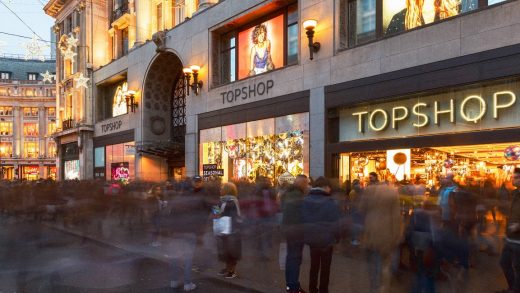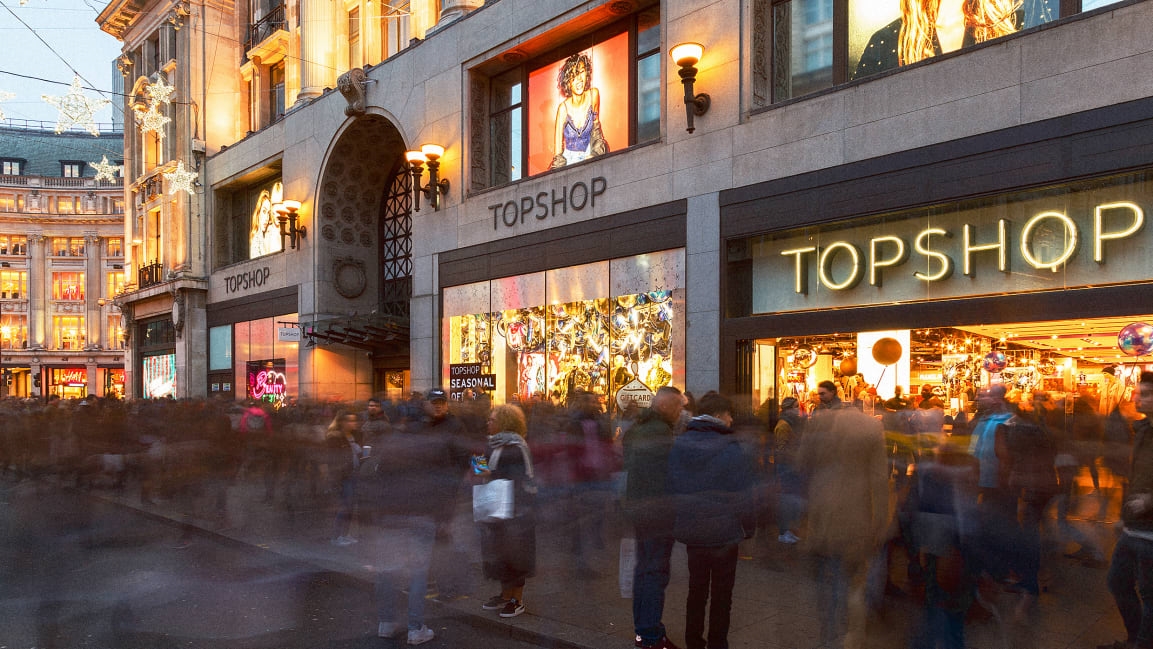Where Topshop went wrong
The British fashion group Arcadia has fallen into administration (which is similar to filing for bankruptcy in the U.S.), putting 13,000 jobs at risk. Arcadia’s market share slumped from around 4.5% in 2015 to 2.7% in 2020. The group’s extensive portfolio of stores, which includes British staples like Dorothy Perkins, Burton, and Miss Selfridge, has long felt outdated.
Arcadia’s prominence has waned over the years with dozens of outlets closing. Many industry experts and past employees lay the blame at owner Philip Green’s feet, citing lack of investment in online retailing and outdated ways of sourcing product.
Topshop, a stalwart of teen and twentysomething fashion, and the jewel in the Arcadia crown, has become the latest fatality of this crumbling empire, and undoubtedly the one that has tipped it into administration.
Topshop’s Legacy
The legacy of the Topshop women’s fashion chain started in Sheffield and London in 1964, in the basements of the Peter Robinson department stores. The aim was to sell fashion made by young British designers. Crucial to the brand’s early success was Diane Wadey, a buyer known in the business for having a keen eye for young talent.
In 1974, parent company Burton Group made Topshop a stand-alone store. Within two years, the brand’s primary target market became 13- to 24-year-olds, it opened 55 stand-alone stores, and garnered more than a million pounds in profit. The brand was so successful that Burton launched its male equivalent, Topman, in 1978.

The 1980s and early 1990s saw a fragmentation of the U.K. mass market as the emergence of value retailers such as Matalan, New Look, and George at Asda put pressure on price reductions for fashion retailers. To maintain a competitive advantage, Topshop handed its reins over to a lady hailed as the “most influential person on the British high street” during the mid-1990s, Jane Shepherdson. Shepherdson has been credited with democratizing women’s style and changing the way they buy and wear fashion. Under her reign, the brand was transformed into a style mecca, creating well-designed, style-savvy clothing.
By the early 2000s, the retail landscape was changing. The advent of the internet meant that designer catwalk collections, which had previously been a closely guarded secret, now became readily available at the touch of a button. Clever design and buying teams were able to use these catwalk images, interpret them swiftly for production, and cut the six-month wait for more mass-market versions of much-desired designs. Shepherdson and her team excelled in exploiting this opportunity by delivering up-to-the-minute and competitively priced fashion to the masses in a matter of eight weeks.
After 20 successful years at the helm, and with profits at more than 100 million pounds a year, Shepherdson staged a dramatic departure from Topshop. The press blamed a fallout between her and Green over the decision to allow supermodel Kate Moss to design lines for the chain. However, industry insiders and Shepherdson herself deny this. From this moment on, the road ahead for Topshop under new management was a tough one.
Where it all went wrong
Ironically, Topshop’s unique selling point was its demise. The more fashion lines the retailer gave to its consumers, the more demanding they became. The competition was also becoming fierce as the market exploded with world-class international retailers, including online upstarts like Boohoo and Asos, and extra-value retailers like Primark, which combined low prices and savvy digital marketing techniques.
As more people started to shop online, Green failed to invest in digital retail channels, leaving his company unable to keep up with competitors. Online sales are increasing year on year, driven by Topshop’s key demographic—the 14- to 24-year-old market.
While people shop online more, footfall to brick-and-mortar stores has massively decreased in the last 10 years and dropped massively during the pandemic. Topshop’s fixation on physical retail and unwillingness to let go of shops was also a setback.
While under Shepherdson, Topshop had been nimble in its reaction to catwalk styles; the company lost this ability after her departure. Fashion companies need to react quickly to emerging trends. Bringing suppliers of products closer to home ensures that companies can capitalize on what’s hot in a speedy manner. The closer the supplier, the shorter the lead time, making a retailer more flexible in its stock turnover. However, Green’s lack of strategic supplier relationships and his proclivity for buying from Asia meant that it took a long time to get a product from concept to shop floor.
Sales also took a hit in 2018 when shoppers boycotted Topshop after Green was accused of sexually harassing and racially abusing staff. Activists also pressured the pop star Beyoncé, who had launched her popular activewear brand IvyPark under Topshop in 2016, to cut ties with Green and Arcadia.
The collapse of the Arcadia group marks a significant corporate casualty of the pandemic. However, Topshop is unlikely to disappear altogether. Strong heritage and high brand awareness means it will probably continue to exist, even if that means only online.
Julie Hodson is a senior lecturer in Fashion Business at Manchester Metropolitan University. This article is republished from The Conversation under a Creative Commons license. Read the original article.
(21)



